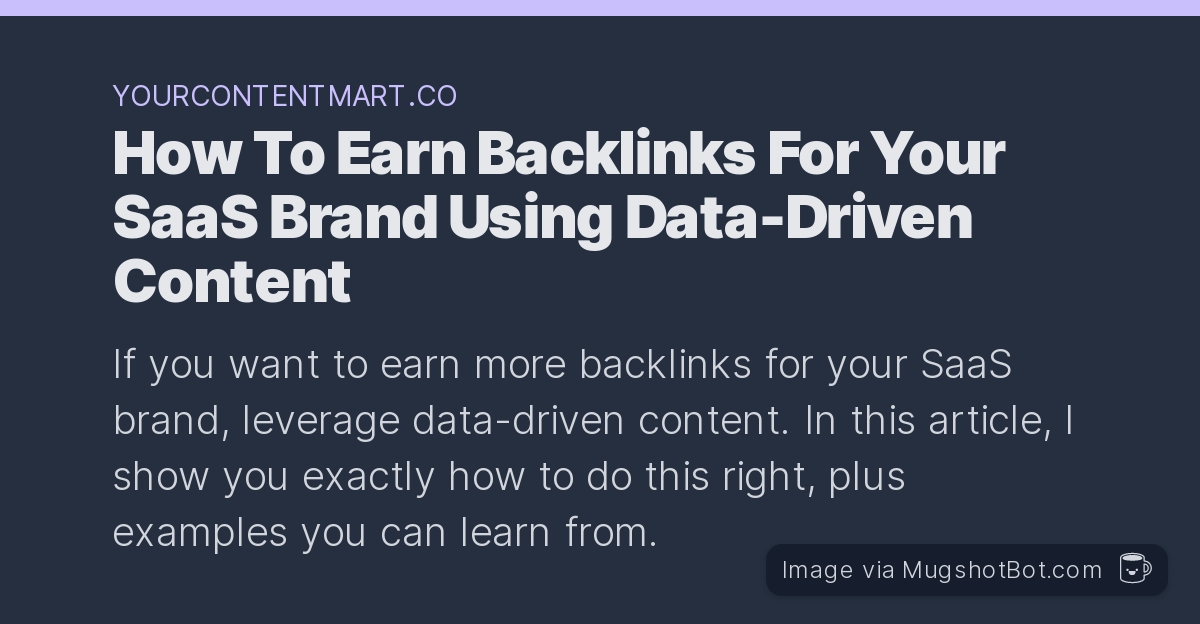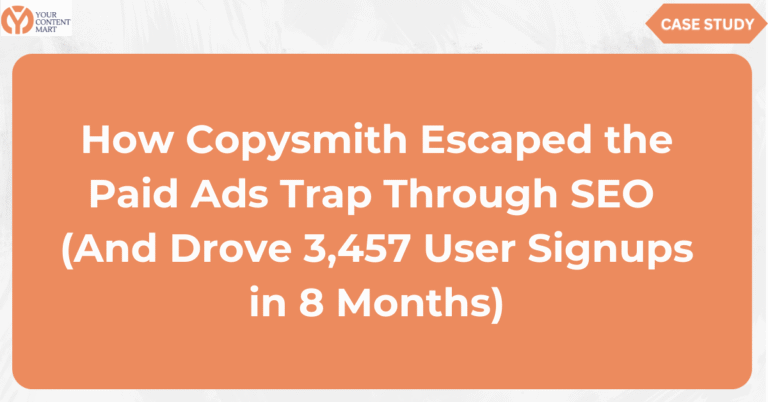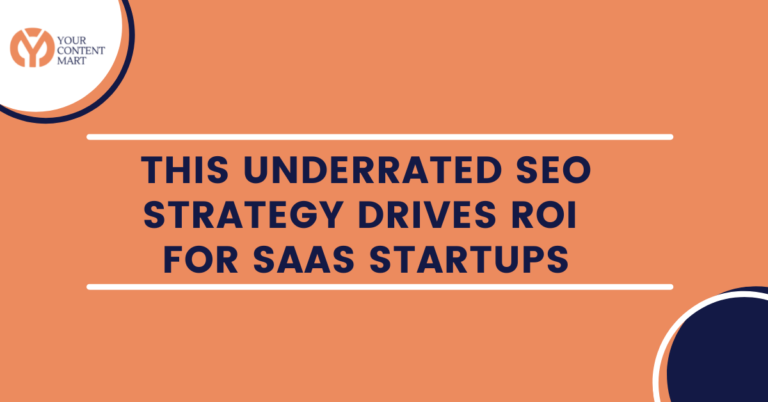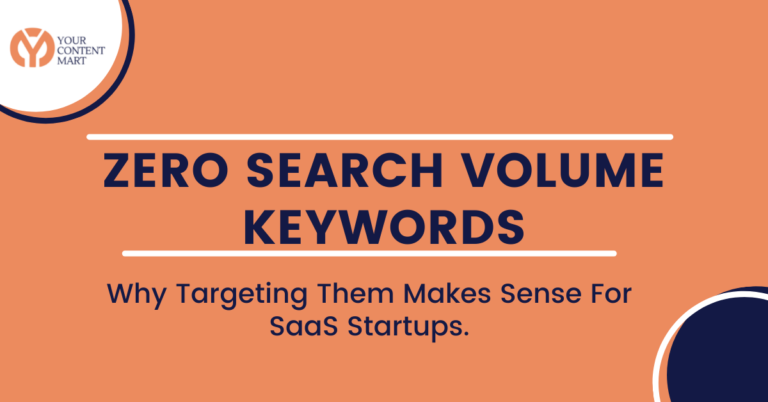You need backlinks to rank high on Google, isn’t it?
But how exactly do you earn them from other websites and top publications without begging or paying for them?
That’s the challenge you’ll most likely be facing as a SaaS founder or marketer.
What if I told you that you can create content pieces on your website that naturally earn backlinks for your SaaS?
What if I show you how successful SaaS companies are using this same content type to earn thousands of high-quality backlinks on a consistent basis?
In case you’re wondering what that is and how it could work, look no further.
In this post, I’ll share with you how to use data-driven content to earn backlinks for your SaaS brand.
After reading this article, you’ll learn the following:
- What exactly is data-driven content?
- Why backlinks are important for growing a SaaS brand
- The 2 popular ways to acquire backlinks for your SaaS product
- How to earn natural backlinks using data-driven content
- Data-driven content marketing examples you can learn from.
Let’s get started…
TABLE OF CONTENTS
Why are Backlinks Important for Growing a SaaS Brand?
Here is a quick assignment for you.
Take a look at any of the top-ranking popular SaaS websites in your niche, you’ll most likely find out that they’re powered by thousands of backlinks.
And guess what?
This has helped them to dominate the SERPs for tons of keywords and it seems almost impossible to outrank them.
What exactly is playing out here?
You see…
In the eyes of Google, a link is like a “vote of confidence”.
So, if website A links to website Z, it means that website A is telling Google that website Z should be trusted.
That “link” signals to Google that website Z is an authority in their niche (topic) and should be ranked higher (All things being equal).
What does this show?
It’s simple….
Links are the currency of the internet.
The more quality and relevant backlinks a website has, the higher the chances of ranking high on the search engine.
In fact, Google’s Partner Development Manager, Andrey Lipattsev stated that links are one of the top three ranking factors in Google’s algorithm.
That’s not all…
Multiple SEO industry researches have shown that there’s a correlation between the number of backlinks a page has and its ranking on Google.
Here are a few of them:
- Ahrefs studied over 1 billion pages and found out that pages with more referring domains linking to them, get more organic search traffic.
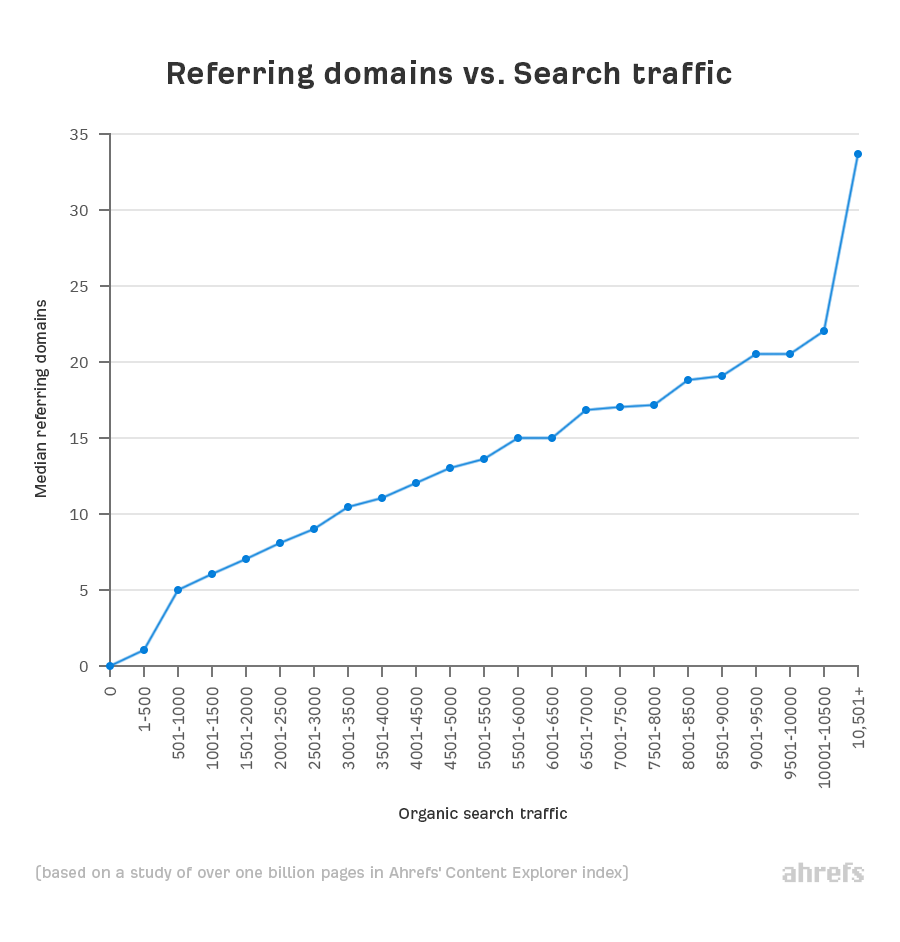
- Backlinko analyzed over 11.8 million Google search results and found out that the number 1 result for each query has about 4 times more backlinks compared to number 2-10 results.
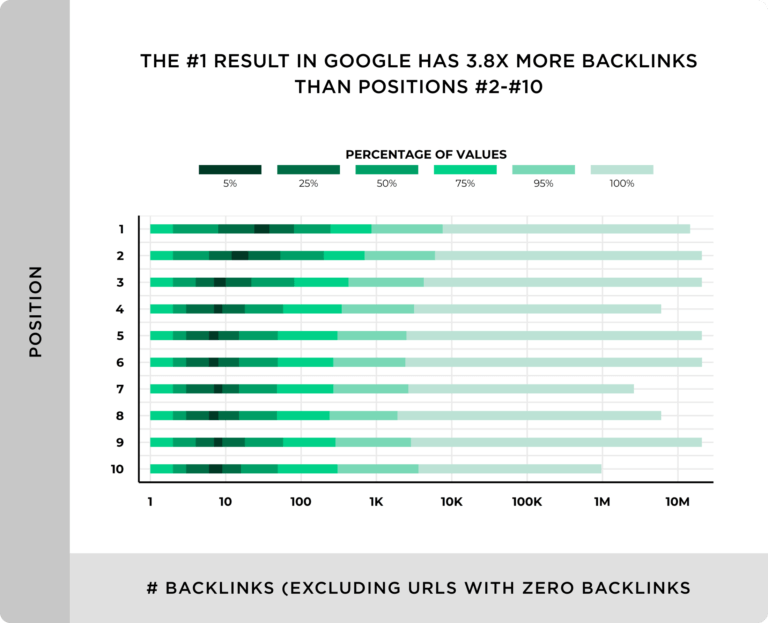
As you can see…
Backlinks are uber-important to build an authoritative website in your niche.
Without them, you’ll struggle to make SEO a growth enabler for your SaaS business.
Two Popular Ways to Acquire Backlinks To Your SaaS Product
If you want to acquire backlinks to your SaaS product, here are the two (2) popular ways to do that:
1. Build backlinks through outreach
To build backlinks, you need to reach out to website owners and bloggers in your niche to link to you. It requires sending cold emails and making people see reasons why they should link to you and in some cases incentivizing them to do so.
Examples of link building outreach are:
- Guest posting
- Link insertion
- Link exchange
- Showing up on podcasts
- Press mentions
- Roundups
2. Earn backlinks by doing something amazing
Earning backlinks is when people decide to link to your content because they find it valuable and believe that it’ll be helpful for their readers.
When you earn backlinks, people will link to you without any form of outreach, in most cases.
How Data-driven Content Can Help You Earn Backlinks Naturally
Take a look at the two websites I linked to previously. What do they have in common?
You can see that they’re articles that buttress my point about the importance of backlinks with relevant data and statistics. And I’m sure a lot of websites link to them too for the same reason.
And the best part…
They didn’t do any form of outreach before I linked to them.
What this means is that if you want to earn backlinks for your SaaS business, you should invest in data-driven content.
What Exactly is Data-driven Content?
Data-driven content involves conducting research, studies, analyses, and surveys, about your industry and presenting the findings to your audience.
For this SaaS content writing type, you’re providing relevant information that other website owners and bloggers can rely on to add more depth to their stories.
Think about it this way…
Someone wants to write an article about the evolution and growth of SaaS companies.
For a piece of content like this, you’d most likely need to show your readers the statistics about the number of SaaS companies in the world right now.
So, you’ll want to reference a source for that piece of information.
To buttress that fact, you need data-driven content.
So, if you’ve published in-depth research on the number of SaaS companies in the world on your website, you’ll most likely earn a backlink from that piece of content.
As you can see…
Data-driven content helps you provide helpful and valuable information for your readers.
Why is Data-driven Content Important For a SaaS Business
Here are some reasons to include data-driven content as a core part of your content marketing strategy.
1. Show readers that you’re an authority in the niche
Imagine that everyone in the industry you’re in references and links to a piece of data-driven content that you’ve published in their articles.
What does that mean?
It shows that you’re an authority in the niche, and most people will start to recognize your SaaS brand more.
And anyone who stumbles on that content will most likely have your brand name imprinted in their minds. That way, you can penetrate your niche and become a well-known name in the industry.
2. Understand the challenges in your industry
With data-driven content, you won’t rely on assumptions to arrive at any conclusions you make.
Rather, you’d have access to first-hand information from your target audience and prospects.
That way, you can have a better idea of the challenges in your industry and know more about them.
This can also help you in creating pain-point content pieces that address their deepest worries and concerns.
3. Solve your audience’s problems with data
Before you can solve a problem, you need to know more about it, right? And if you have access to the data provided by your target audience, solving the problems becomes much easier.
Types of Data-driven Content
Here are some types of data-driven content that you can create for your SaaS business.
1. Original Research
This involves using unique and patent data available to your company.
In this case, you’re the primary data source and don’t rely on other sources or websites for information.
You can create this type of data-driven content if you have a large dataset to work with or by collaborating with other websites in your industry
Here is a great example of original research.
2. In-depth analysis
For this type of data-driven content, you don’t need to have access to unique or original data.
Rather, you can analyze some websites or existing information in your industry and come up with the conclusion of your findings.
In this in-depth analysis example, Process Street analyzed over 250 SaaS landing pages and shared their findings with the audience.
3. Surveys
If you have access to a sizeable number of existing customers, you can run surveys.
You can publish your findings and conclusions from a survey as data-driven content.
If your customer size isn’t large enough, you can collaborate with subject matter experts in your industry and thought leaders to make that happen.
In this example, BambooHR surveyed over 1000 employees to understand what a great onboarding process means to employees.
4. Statistics pages
This is by far, the easiest type of data-driven content to create.
This involves curating statistics on the internet related to your industry and publishing them on your website.
In this case, you make use of existing statistics to create something unique.
Here is a great example of what a statistics page looks like from the team at Snov.
By leveraging statistics pages, Steven Macdonald earned 5,000 backlinks just from 6 posts.
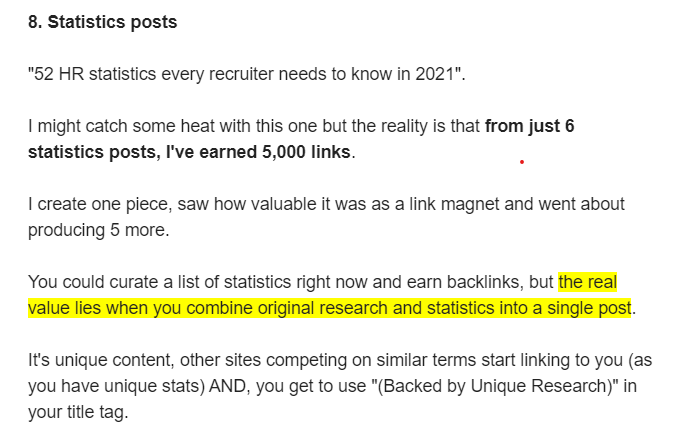
5. Industry studies
There are popular beliefs that everyone in any industry seems to agree with but have no facts to back them up.
You can conduct in-depth industry studies, to confirm if these beliefs are actually true or not.
This is exactly what Brian Dean did with his popular post on Google’s 200 ranking factors.
While most SEOs know that there are factors that Google uses in its ranking of websites. Brian filled the gap by studying each of these factors to confirm if it’s actually a thing or not.
Data-Driven Content Examples You Can Learn From
Want some examples of data-driven content that you can learn from? Here are two (2) that I found interesting.
How Buffer Earns Thousands Of Backlinks With Its Annual State of Remote Work Report
In 2017, Buffer released its first state of remote work report. This has become an annual tradition for the company as it collaborates with other top players in the SaaS niche to release this in-depth report.
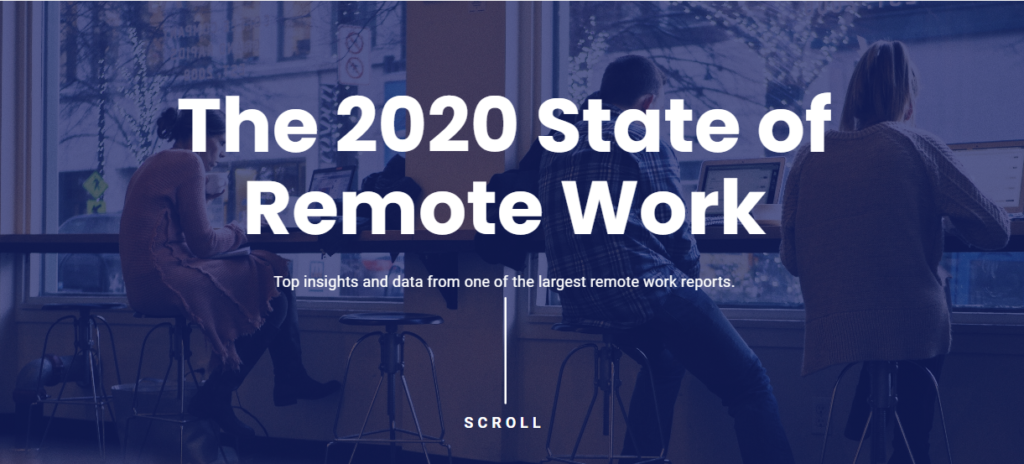
And each year, the report generates tons of backlinks for Buffer.
Take the 2020 state of remote work report as an example. According to Ahrefs, it generated over 5,000 backlinks from more than 2000 referring domains. And the best part, most of these backlinks (78% to be precise), are dofollow.

According to Ahrefs, it generated over 5,000 backlinks from more than 2000 referring domains.
And the best part…
Most of these backlinks (78% to be precise) are dofollow.
That’s not all…
A handful of these backlinks are from authoritative websites such as Forbes, BBC, Weforum, Entrepreneur, Search Engine Journal, The Balance Careers, and so on.
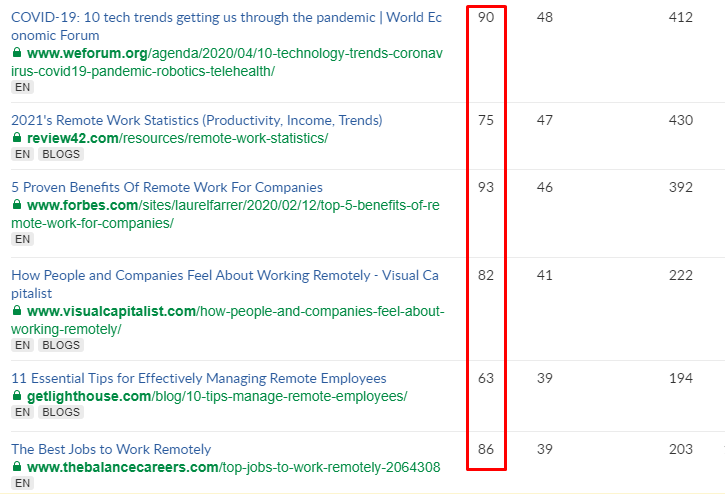
From publishing one data-driven report alone, Buffer was able to get thousands of websites to link to it.
Even if most of the people who visit Buffer from this report don’t convert to trial signups and customers.
The backlinks will bolster their website’s domain authority and help them rank high in Google for competitive keywords.
How Nextiva Generated Thousands of Backlinks With a Statistics Page
Buffer relied on raw data from surveying over 3000 remote workers to come up with their report.
While this might be possible for Buffer, not every SaaS business out there will have access to this kind of data.
This is why this example from Nextiva is interesting.
Instead of creating data-driven content from a large pool of data, they curated already available information on the internet.
Take a look at this customer service statistics page from Nextiva.
You’ll see that the over 100 statistics cited in the content aren’t original data from them.
What they did was to source these statistics from authoritative websites such as Microsoft, Forrester, Statista, Accenture, Ameyo, AE, and so on, and put them together as a post.
From this statistics page alone, Nextiva has generated over 1500 backlinks from about 700 domains.

In fact, according to SEMrush, this page ranks for over 620 keywords and brings in about 300 organic traffic visitors every single month.

Here is the fact…
If you want to earn backlinks at scale for your SaaS business and increase your domain authority, you should leverage data-driven content.
How To Conduct Data-driven Surveys That Earn Backlinks
Expert insight from Michelle Lynn
Co-founder of Mantis Research
Here is the general process I suggest you follow when conducting your own survey for content:
Step 1: Make sure you have the right mindset
Remember: You are trying to test a hypothesis, not prove something.
You never want your research to point to your product/service as the magic solution, instead, think about the questions people in your industry are looking to answer with data and answer those questions as honestly as possible.
Step 2: Determine what success looks like
Are you trying to build authority? Generate leads? Get press? Something else?
Step 3: Decide on the focus of your research
Choose something that is meaningful to your audience, aligns with your audience, and studies something new. (You don’t want to repeat something that has already been done!)
Step 4: Determine how you will get responses
You essentially have three options: your list, a partnership, or a panel.
You can read more about each of these here.
Step 5: Decide who you want to take your survey and who you want to disqualify
Disqualifying respondents is important because you want to make sure that the right people are participating — even if this results in fewer responses.
Step 6: Document the demographic questions you want to ask
For a consumer-based study, this includes things such as gender, location, and age/generation.
When surveying B2B respondents, you may want to ask about things such as industry, company size, role, and years of experience.
Step 7: Write your survey questions
There is a lot more that can be said about this step, but to keep things simple, remember that you need to be as clear as possible.
Step 8: Build in quality checks
These are questions you can ask to verify the right people are answering your survey and they are paying attention.
While there is a lot more that can be said about this step, remember to always ask at least one write-in question.
Step 9: Program, test and launch your survey
Step 10: Clean your data
Yes, this may mean that you are removing responses, but this is important if you want quality data.
If you are using a panel, they should backfill any bad responses for you.
Step 11: Analyze the data and pull out the stories
Final Thoughts: Earn Natural Backlinks For Your SaaS Brand With Data-driven Content
Backlinks are important if you want to rank high on Google, yet hard to get.
Most people settle for the traditional way of acquiring backlinks, which involves:
- Sending email outreach
- Showing them why they should link to you
- Promising them something in return, and
- Hoping that they link to you.
While this works, it takes tons of time and resources, if you want to get the best results from it.
Not only that, email outreach has got a bad rep these days, and most webmasters and website owners are skeptical about responding to them.
With data-driven content, you do the opposite of this and get better results in most cases.
Instead of begging people for backlinks, you create a valuable and helpful content asset that most people would be willing to link to.
As a SaaS content marketing agency, this is one of the content strategies that we implement for our clients.
If you’d like us to help with your SaaS content marketing strategy, click on this link to get a free content analysis from our lead content strategist.
You can as well join our newsletter, SaaS Growth Bites, below to receive exclusive insights and tips every Thursday, on the best way to grow a SaaS business using content marketing.

